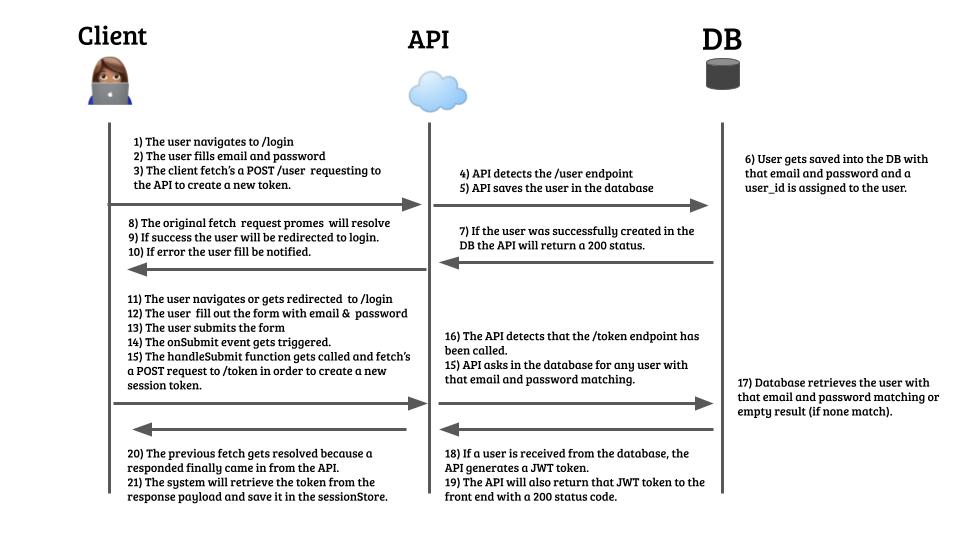Start interactive tutorial
Authentication system with Node and React.js
Almost every website in the world has user authentication. In this project you have to implement user authentication using Node for building a backend REST API and React.js and sessionStorage API for the frontend web application.
🗒️ Instructions
Implement an authentication system with the following parts:
- Signup: A person must be able to pick his/her email, and any password and submit the form. A new user must be created in the database and the user must be redirected to the login form afterward.
- Login: The user fills out their email and password and it's redirected to the private dashboard after successful authentication.
- Validation: Any page considered "private" must always validate that the current user is valid, if not, the page must redirect the user back to login.
- Logout: Any moment the user must be able to press "logout" in the navbar and it will get redirected back to the login path.
At least the following pages and react components must be implemented into the project:
| Path | Component | Functionality |
|---|---|---|
/signup | <Signup> | Renders the signup form |
/login | <Login> | Renders the login form |
/private | <Private> | Validates that only authenticated users and render this component |
🌱 How to start coding this project:
Do not clone this repository.
- The first step to start coding is cloning the React.js + Node boilerplate on your local computer or opening it using gitpod.
a) If using Gitpod (recommended) you can clone the boilerplate by clicking here.
b) If working locally type the following command from your command line: git clone https://github.com/4GeeksAcademy/expressjs-rest-hello.
💡 Remember to create a new repository, update the remote (git remote set-url origin <your new url>), and upload the code to your new repository using add, commit and push.
More details about the authentication:
Usually an authentication system is implemented in 4 parts:

User signup
At the beginning of every application that are not users or tokens, so the first step that makes sense to build is user signup.
- The user navigates to the
/signuppath at frontend. - The React.js application (probably using the React Router library) will detect the route
/signupand match with its corresponding React.js page component that will take care of rendering the signup HTML. - The user picks and writes an email and password and clicks submit.
- The React.js page is listening to the onSubmit event, it gets triggered and the
handleSubmitfunction fetches the email and password to the backend Node API, probably doing aPOST /tokenrequest with the email and password on the body payload.
User login (start session)
This part of the process occurs only when new tokens have to be generated.
- The user lands in the
/loginpath, in the frontend. - The React.js application (probably using the React Router library) will detect the
/loginpath and match it with its corresponding React.js page component, this page will take care of rendering the login form. - The user fills the login form and submits it.
- The page is listening (waiting) for the form sumbit event to trigger, and it finally triggers because the user submit the form.
- The page now retrieves the username and password information and fetch (POST) that data to the API.
- The API validates that the username and password are correct and returns a
tokenobject. - The frontend application saves that token in the
sessionStorage. - The frontend application redirects to the
/private.
User logout (end session)
This process occurs when the user desires to logout.
- Normally there is a button to log out somewhere in your application.
- The user press that button and the
onClickevent handler is called. - The frontend application removes the
tokenfrom thesessionStorage. - The frontend application redirects to the home page (public).
Token Validation
Any user can just type /private to attempt visiting a private page, that is why we need to implement a validation that prevents the anonymous users to see the content of this page, and we must redirect the user to /login or any other public page. This is usually how the process goes:
- The user types any private URL, for example,
/private - The React.js application (probably using the React Router library) will detect the route
/privateand match with its corresponding React.js page component that will take care of rendering the HTML. - Before rendering the HTML -and only because this is a private route- the component must verify that the sessionStorage contains the authenticated token, you normally would do that in the useEffect (component did mount) because you want to do it very early during the application loading.
- If
sessionStorage👎 does not have thetoken, the current user is not considered to be logged in and the component must redirect to the login view. - If the sessionStorage 👍 does contain the token, the current user is successfully logged in and the rest of the
/privateview component is loaded.